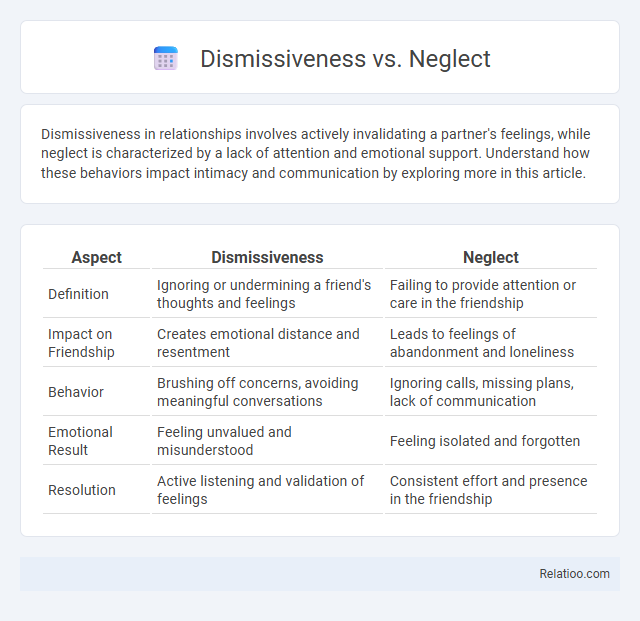Dismissiveness in relationships involves actively invalidating a partner's feelings, while neglect is characterized by a lack of attention and emotional support. Understand how these behaviors impact intimacy and communication by exploring more in this article.
Table of Comparison
| Aspect | Dismissiveness | Neglect |
|---|---|---|
| Definition | Ignoring or undermining a friend's thoughts and feelings | Failing to provide attention or care in the friendship |
| Impact on Friendship | Creates emotional distance and resentment | Leads to feelings of abandonment and loneliness |
| Behavior | Brushing off concerns, avoiding meaningful conversations | Ignoring calls, missing plans, lack of communication |
| Emotional Result | Feeling unvalued and misunderstood | Feeling isolated and forgotten |
| Resolution | Active listening and validation of feelings | Consistent effort and presence in the friendship |
Understanding Dismissiveness: Definition and Key Traits
Dismissiveness is characterized by a deliberate disregard for others' feelings or opinions, often manifesting as minimizing, invalidating, or ignoring concerns. Unlike neglect, which involves a lack of attention or care, dismissiveness actively communicates a lack of value or respect. Your ability to recognize key traits such as defensive attitudes, condescension, and emotional unavailability helps in identifying dismissive behavior and addressing its impact in relationships.
What Constitutes Neglect? Core Characteristics
Neglect constitutes a failure to provide essential care, supervision, or emotional support, leading to harm or risk of harm to Your well-being, characterized by persistent omission rather than active rejection. Core characteristics include lack of adequate food, shelter, medical care, emotional nurturing, or protection from danger, distinguishing it from dismissiveness, which involves minimizing feelings without necessarily jeopardizing basic needs. Understanding these differences is crucial for identifying the subtle yet damaging effects neglect imposes on physical and emotional development.
Dismissiveness vs Neglect: Core Differences
Dismissiveness involves consciously minimizing or invalidating someone's feelings or opinions, while neglect refers to a failure to provide necessary attention or care. Your emotional experience is dismissed through active disregard in dismissiveness, whereas neglect often results from inaction or omission. Understanding these core differences helps identify the impact of each behavior on relationships and emotional well-being.
Psychological Impact of Dismissiveness
Dismissiveness profoundly affects psychological well-being by undermining self-esteem and fostering feelings of invalidation and helplessness. Unlike neglect, which involves the absence of care, dismissiveness actively rejects or minimizes Your emotions and experiences, leading to increased anxiety and depression. Understanding these distinctions is crucial for addressing the emotional damage caused by dismissive behavior and promoting healthier interpersonal relationships.
Emotional Consequences of Neglect
Neglect in relationships leads to profound emotional consequences such as feelings of abandonment, low self-worth, and chronic loneliness. Unlike dismissiveness, which involves invalidating emotions, neglect is characterized by the absence of emotional support and attention, creating a void that damages trust and attachment security. This emotional deprivation can result in long-term psychological issues including anxiety, depression, and difficulty forming healthy connections.
Common Signs of Dismissive Behavior
Dismissive behavior often manifests through ignoring or minimizing your feelings, interrupting conversations, and showing a lack of empathy or validation. Common signs include turning away when you speak, dismissing your opinions as irrelevant, and avoiding eye contact during important discussions. Recognizing these patterns helps distinguish dismissiveness from neglect, which involves a more passive lack of attention or care.
Identifying Patterns of Neglect in Relationships
Identifying patterns of neglect in relationships involves recognizing consistent emotional unavailability, lack of responsiveness to needs, and minimal engagement in communication, which are key indicators of neglect. Dismissiveness manifests as minimizing or invalidating a partner's feelings, often leading to emotional distance, whereas neglect is characterized by sustained absence of attention or care. Differentiating between occasional dismissiveness and ongoing neglect requires assessing the persistence and impact of these behaviors on emotional intimacy and relational health.
Dismissiveness in Communication: Warning Signals
Dismissiveness in communication often manifests as subtle or overt disregard for others' opinions and feelings, leading to a breakdown in trust and emotional connection. Warning signals include interrupting frequently, ignoring contributions, and belittling concerns, which can escalate conflicts and undermine healthy dialogue. Recognizing these behaviors early is crucial for fostering mutual respect and effective interpersonal relationships.
Long-Term Effects: Dismissiveness vs Neglect
Dismissiveness often leads to feelings of invalidation and low self-esteem, affecting your emotional well-being over time, while neglect can cause deeper psychological harm, including attachment issues and developmental delays. Long-term effects of dismissiveness may include impaired communication skills and difficulty forming trusting relationships, whereas neglect frequently results in chronic emotional and physical health problems. Both behaviors negatively impact mental health, but neglect typically produces more severe and pervasive consequences.
Healing and Recovery Strategies: Dismissiveness and Neglect
Healing from dismissiveness involves cultivating self-awareness and validating one's emotions through therapeutic approaches such as cognitive-behavioral therapy (CBT) or mindfulness practices. Recovery from neglect requires creating a supportive environment that fosters secure attachments and consistent emotional nourishment, often facilitated by trauma-informed counseling or attachment-based therapy. Both conditions benefit from building resilience, establishing healthy boundaries, and engaging in restorative relationships to promote long-term emotional well-being.

Infographic: Dismissiveness vs Neglect
 relatioo.com
relatioo.com